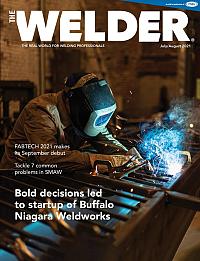Technical Liaison Manager
- FMA
- The Fabricator
- FABTECH
- Canadian Metalworking
Categories
- Additive Manufacturing
- Aluminum Welding
- Arc Welding
- Assembly and Joining
- Automation and Robotics
- Bending and Forming
- Consumables
- Cutting and Weld Prep
- Electric Vehicles
- En Español
- Finishing
- Hydroforming
- Laser Cutting
- Laser Welding
- Machining
- Manufacturing Software
- Materials Handling
- Metals/Materials
- Oxyfuel Cutting
- Plasma Cutting
- Power Tools
- Punching and Other Holemaking
- Roll Forming
- Safety
- Sawing
- Shearing
- Shop Management
- Testing and Measuring
- Tube and Pipe Fabrication
- Tube and Pipe Production
- Waterjet Cutting
Industry Directory
Webcasts
Podcasts
FAB 40
Advertise
Subscribe
Account Login
Search
Diagnosing flux-core welding stainless steel failures
- By David Meyer and Rob Koltz
- Updated January 25, 2023
- September 1, 2021
- Article
- Consumables

Why does a single-pass stainless steel weld using FCAW keep failing inspection? David Meyer and Rob Koltz take a closer look what might be causing these failures. Getty Images
Q: We are repair welding steel scrapers inside of a dryer system that is in a wet environment. Our welds are failing inspection because of porosity, undercut, and weld cracking. We are welding A514 to A36 with 0.045-in.-dia., all-position, flux-cored 309L with 75% argon/25% carbon dioxide gas for better wear resistance.
We tried to use a carbon steel electrode, but the welds wear away too fast and we found that the stainless performs better. All welds are done in the flat position and are 3/8 in. Because of extreme time constraints, all welds are made in a single pass. What could be causing our welds to fail?
A: Based on the information you have provided, we see a few areas of concern.
Undercut typically occurs because of weld parameters that are way out of specification, improper welding technique, or both. We can’t comment on the weld parameters since we don’t know them. Undercut that occurs in the 1F position usually stems from excessive weld puddle manipulation or travel speed that is either too fast or too slow.
Since the welders are trying to deposit a 3/8-in. fillet weld in a single pass with a small-diameter flux-core wire, the possibility for excessive weld gun manipulation may be partially to blame. However, this seems like a case of using the wrong tool for the job rather than a technique issue, and here’s why.
Porosity is caused by impurities in the weld joint, loss of or excessive shield gas, or excessive moisture absorption in the flux-cored wire. You mentioned this is repair work inside of a dryer for a wet media, so if the weld joints are not thoroughly cleaned, this may be the main cause of the porosity.
The filler metal you are using is an all-position flux-core wire, and these wire types have a fast-freezing slag system. This is necessary to support the weld puddle when welding vertical-up or overhead. The downside of fast-freezing slag is it will solidify before the molten weld puddle underneath it. If gases are still being released, oftentimes they’ll get trapped and show up later as porosity or surface worm tracks. This is magnified when welding in the flat position with a small-diameter wire and attempting to deposit a large weld in a single pass, like in your application.
The weld cracking at the starts and stops of your welds may be caused by a few things. It’s likely you are experiencing a lack of fusion (LOF) at the root of the weld since you are using a small-diameter wire to lay a large weld bead. With high residual weld stresses and LOF at the root, weld cracking is a common occurrence.
For this wire diameter, you should use two or three passes to complete a 3/8-in. fillet weld, not one. You may find making three passes without defects is faster than making a single-pass weld with defects and then having to make repairs.
However, the other issue that may be playing a bigger role in the weld cracking is incorrect ferrite levels in the weld, which often is a leading cause of cracking. The 309L wire was developed for welding stainless steel to carbon steel, not carbon-to-carbon steel. The specific weld chemistry of this product is also taking into consideration some base metal dilution from both base materials. So, in a stainless-to-carbon-steel application, some alloy pickup from the stainless helps balance out the chemistry and produces an acceptable ferrite number. Using a filler metal with approximately 50% ferrite, such as 312 or 2209, will eliminate the possibility of cracking due to low ferrite.
The best method for providing superior wear resistance is welding the joint with a standard carbon or stainless steel electrode and then adding a layer of hardfacing electrode. However, you did mention that you are under a very tight time constraint and any multipass welding scenario is not possible.
Try converting to a larger-diameter wire such as 1/16 in. or greater. Staying with a gas-shielded flux-core wire is ideal since it provides better weld cleaning action and better protection from air drafts than a non-flux-cored wire. However, instead of an all-position wire, a wire that’s intended for the flat and horizontal position only would minimize porosity or worm tracking. You should also change your filler metal from 309L to either 312 or 2209.
About the Authors


Rob Koltz
Application Engineer
411 S. Ebenezer Rd.
Florence, 29501
636-485-2253
About the Publication
Related Companies
subscribe now

The Welder, formerly known as Practical Welding Today, is a showcase of the real people who make the products we use and work with every day. This magazine has served the welding community in North America well for more than 20 years.
start your free subscription- Stay connected from anywhere

Easily access valuable industry resources now with full access to the digital edition of The Fabricator.

Easily access valuable industry resources now with full access to the digital edition of The Welder.

Easily access valuable industry resources now with full access to the digital edition of The Tube and Pipe Journal.
- Podcasting
- Podcast:
- The Fabricator Podcast
- Published:
- 04/16/2024
- Running Time:
- 63:29
In this episode of The Fabricator Podcast, Caleb Chamberlain, co-founder and CEO of OSH Cut, discusses his company’s...
- Trending Articles
Sheffield Forgemasters makes global leap in welding technology

Welding student from Utah to represent the U.S. at WorldSkills 2024

Lincoln Electric announces executive appointments

Lincoln Electric acquires RedViking

Engine-driven welding machines include integrated air compressors

- Industry Events
16th Annual Safety Conference
- April 30 - May 1, 2024
- Elgin,
Pipe and Tube Conference
- May 21 - 22, 2024
- Omaha, NE
World-Class Roll Forming Workshop
- June 5 - 6, 2024
- Louisville, KY
Advanced Laser Application Workshop
- June 25 - 27, 2024
- Novi, MI



























